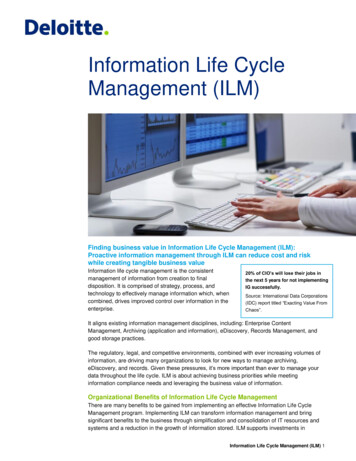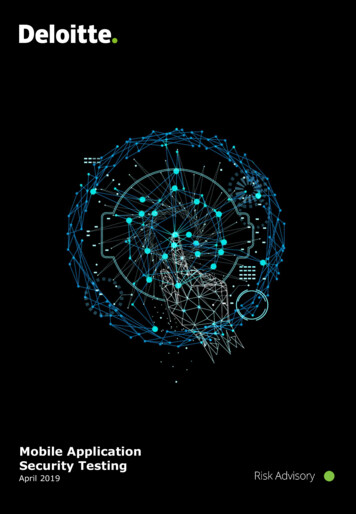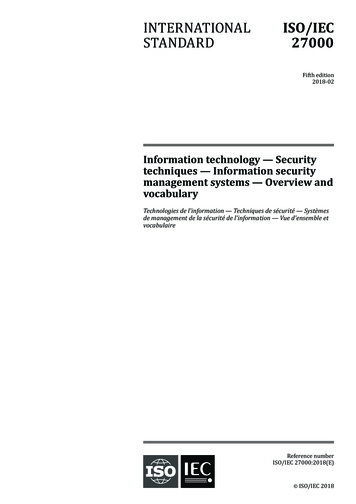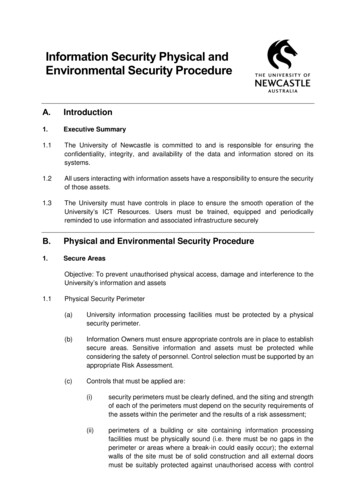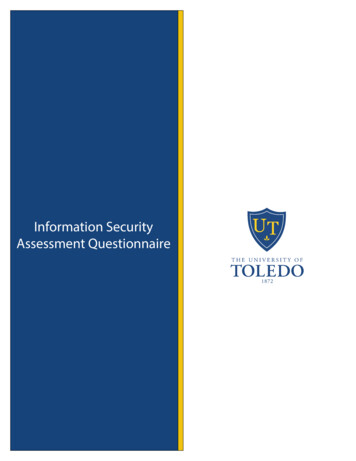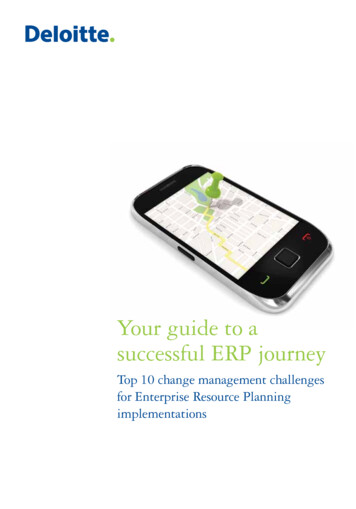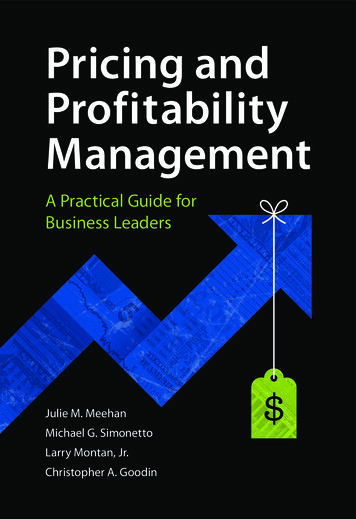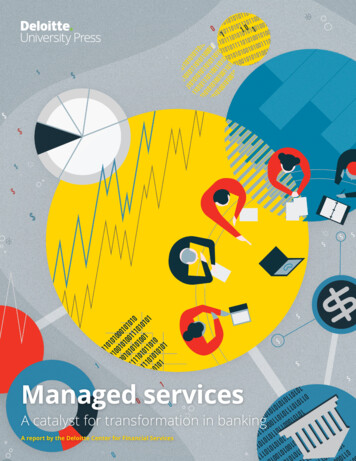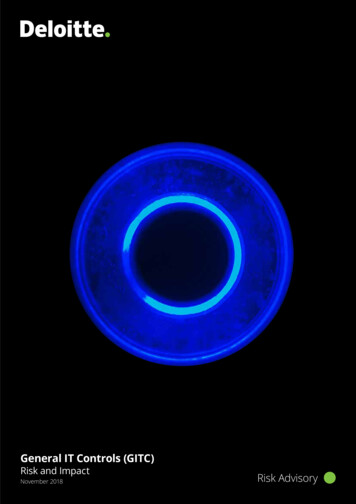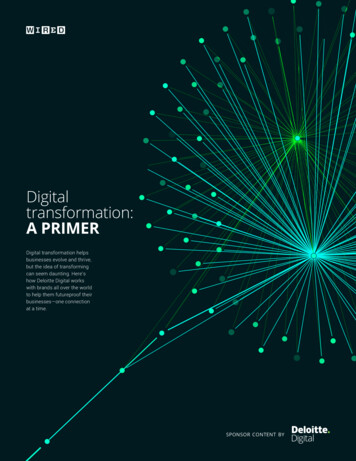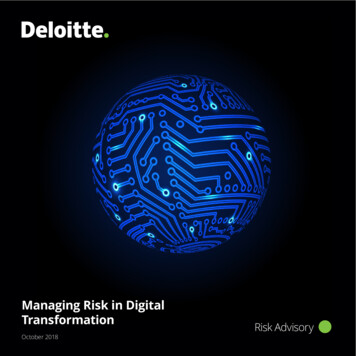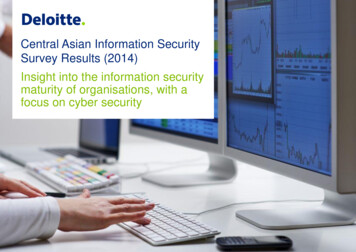
Transcription
Central Asian Information SecuritySurvey Results (2014)Insight into the information securitymaturity of organisations, with afocus on cyber security
Introduction and Executive summaryFrom September to November 2014 Deloitte performed its first “information securitysurvey” in Central Asia to better understand the current state of information securityprogrammes and governance structures at organisations in the region. The surveycovers various industries and addresses how organisations view, formulate,implement and maintain their information security programmes.The 39 survey questions covered the following areas:1. organisational information2. information security attacks and threats3. information security data and technologies andExecutive summaryThe survey identified the five most relevant conclusions on the current state ofinformation security programmes (cyber security) in Central Asia, as follows:1. Majority of companies have not been exposed to cybersecurity incidents.2. Information security policies, procedures and responsibilities are mostly in placeand defined.3. Insufficient controls to ensure third parties, (i.e. vendors / partners), comply withappropriate security standards.4. monitoring and reaction to identified security threats4. Awareness of business (senior) management and end-user aroundcybersecurity risks is insufficient.The survey focused on cyber security risks and to that end we approachedapproximately 100 companies to fill in the online survey questionnaire.5. Though basic security measures are in place, more advanced solutions areuncommon.We stipulate that we present the survey results without making a distinction byindustry or organisation size and that the results are ‘anonymous’ to avoid makingreference to individual organisations.Later in this report we provide more detailed insight on survey findings.We would like to thank those organisations that participated in the survey for theircooperation. We would like to encourage other companies to participate in the nextDeloitte “information security survey”. 2015 Deloitte LLP2
Comparing global trends with the information securitystatus in Central AsiaThe number of information security incidents has been increasing globally, rangingfrom passive monitoring of communications to close-in attacks.Undoubtedly, the recent Sony Pictures cyber attack, which involved hackersaccessing some of the corporation’s most confidential data, has garnered a lot ofmedia attention, as did a massive data breach at JPMorgan Chase & Co. thatended up in 76 million records being stolen. Another example relates to thecompany “Home Depot” where credit card details of 56 million customers wheresyphoned, using Malware installed on cash register system.Central Asia has also seen a number of security incidents making it to the news,However compared to other regions, the number of attacks appears to be limitedand for the ones that have been reported, little information is available on theactual impact. According to the responses in this survey, approximately 65% ofrespondents have not experienced cyber attacks directed at their organisation (seequestion 1).Although the number of publicly known cyber attacks appears to be small, thisdoes not mean that organisations in the region are immune, and could ever beexisting under a false sense of security. Given global trends and the increasednumber of attacks and attention given to cyber security, it could very well be thatCentral Asia may become the next target for hackers in the near future. When - notif - this happens, organisations need to be prepared. 2015 Deloitte LLPQuestion 1: Have you suffered a breach in the last 12 months (multiple answerspossible)?Information not availableOthersWeaknesses higlighted during testingLost assets (lost/stolen laptops or memorycards)MalwareHacker attacksVirus attacksWe were not exposed to hacking0%10% 20% 30% 40% 50% 60% 70%The majority of companies have notbeen exposed to cybersecurityincidents. However, evidence isinsufficient as to whether this is realityor merely perception.3
Profile of Central AsianInformation Security surveyrespondents 2015 Deloitte LLP4
Profile of Central Asian Information Security surveyrespondents (1/2)Unsurprisingly, 65% of the respondents are in the Telecommunications andFinance industry (see question 2), which is not surprising as they are theindustries most prone to cyber attacks.The majority of respondents (58%) employ more than 10 people in their ITDepartments. However, the survey also includes smaller IT-departments as show inquestion 3 below.Question 2: Which industry is your organisation in?Question 3: How many people does your IT-department employ?Finance1-2Mining22%14%Retail trade s14%6-10Technology11-15Energy14%7%14%Transport and Logistics22% 15OthersIn the meantime, governments have started to pay increased attention to thesecurity of their strategic activities and assets (such as refineries and powerstations) to protect critical IT-infrastructure - so called SCADA systems - fromunauthorised access. For that reason, the expectation is that senior managementin the resources industry (oil, gas, energy and utilities) should also be focusingon information security. 2015 Deloitte LLP5
Profile of Central AsianInformation Security surveyrespondents (2/2)When asked about IT-governance standards (see question 4), the majority oforganisations referred to internal (head office) policies (65%) and regulatoryrequirements (50%) rather than international standards such as COBIT or ITIL.Question 4: Does your organisation adhere to IT process or security frameworksand/or standards, and if so, which ones (multiple answers possible)?OthersYes, ISO / IEC 27000Yes, COBITYes, ITILYes, regulatory standardsYes, parent organisation standardsNo0% 2015 Deloitte LLP10%20%30%40%50%60%70%6
Corporate informationsecurity maturity in CentralAsia 2015 Deloitte LLP7
Corporate information security maturity in Central Asia(1/4)A number of survey questions refer to information security maturity with respectto the following topics: (1) respondents’ perception of their network security, (2)the existence of policies, (3) the extent to which responsibilities aroundinformation security are defined, (4) current maturity levels and (5) the keychallenges to improving corporate information security.64% of respondents consider their organisation has sufficient security policiesand procedures in place (see question 5) and, interestingly, the number ofrespondents citing weak or insufficient security policies and procedures waszero.Question 5: How secure do you think your organisation’s network is?Sufficiently secure7%Secure to a certain extentMost respondents have information securitypolicies and procedures in place (or willintroduce them in the near future), withresponsibilities for information securitydefined.It appears that the majority of respondents have policies and procedures in place;mostly related to (1) IT-security strategy and (2) business continuity plans (seequestion 6). However, only a limited number of respondents indicated that they haddeveloped a response plan for cyber security incidents.Question 6: Which of the following (policies / procedures) has your organisationdocumented and approved (multiple answers possible)?None of the belowCyber incident response plans29%Information not availableInformation security roadmapBusiness continuity plans64%Not secureHighly secureNot developed but due to be developedover the next 12 monthsInformation security governance structureInformation security strategy0% 2015 Deloitte LLP10%20%30%40%50%60%8
Corporate information security maturity in Central Asia(2/4)Question 7 shows that 57% of the respondents employ a security officer (orequivalent), while the remaining 43% stated that they had not yet definedinformation security duties.Question 8: Who does your information security organisation’s executive(s) reportto?Chief Information Officer (CIO)Question 7: Does your organisation have a (dedicated) departmentresponsible for network security?Chief Financial Officer (CFO)Reports not availableChief Executive Officer (CEO)NoOthersBoard (Board of Directors)Yes, dedicated department / division0%5%10%15%20%25%30%35%40%The majority (close to 80%) of organisations stay up to date on information securitydevelopments through publications and journals, mailing lists and the Internet (seequestion 9 and 10).Yes, but as part of another department(IT or Internal Control Department)0% 5% 10% 15% 20% 25% 30% 35% 40% 45%Question 9: What has raised your awareness of information security attacks (multipleanswers possible)?Information security reports tend not to be sent to the Chief Information Officer(CIO), but rather to the CEO (36%) or Board of Directors (14%). See question 8.OtherPresentations and discussions atconferencesPublications in magazines, on websitesand mailing listsLegal and / or regulatory requirementsThe infrastructure of our organization wasunder attackClients of our organization were attacked0% 10% 20% 30% 40% 50% 60% 70% 80% 90% 2015 Deloitte LLP9
Corporate information security maturity in Central Asia(3/4)Given that each organisation is structured differently and faces different securitythreats (see question 13), the expectation was that more organisations would stay upto date through unique events and specific sources, such as conferences andconsultants.We asked respondents to indicate their current information security status based onour 5-level model. Approximately 30% of respondents admitted being at level 3 (seequestion 11), implying “the presence of a set of defined and documented standardprocesses, and some degree of improvement over time”.Question 10: How do you keep informed of new forms of information securityattacks and threats (multiple answers possible)?Question 11: What maturity level is your organisation currently at?Information not availableOtherTo date, there is no way our organizationcan trace cybercrime promptly, but weconsider this questionLevel 5 - Optimised: focus is on continuousimprovement and innovation.Consulting firms/ external consultingLevel 4 - Managed: benchmarking process,effective management control, adaptationwithout losing quality.Scientific publicationsProviders (vendors)Level 3 - Fixed: a set of defined anddocumented standard processes, somedegree of improvement over time.Social networkLevel 2 - Repeatable: some processes arerepeated, perhaps with reliable results,poor discipline process, agreedbenchmarks.News on websites / blogs / fromprofessional associationsLevel 1 - Basic: undocumented, dynamicchange, ad hoc, uncontrolled and reactive,individual heroicsSecurity conferencesMailing lists0%5%10%15%20%25%30%0% 10% 20% 30% 40% 50% 60% 70% 80% 90% 2015 Deloitte LLP10
Corporate information security maturity in Central Asia(4/4)To qualify for the 3rd maturity level, it is important that policies and proceduresare not only defined but also implemented within an organisation. We are unableto comment to what extent organisations have truly implemented policies andprocedures as that would require a more detailed assessment or audit. However,experience indicates that in reality, the majority of organisations in Central Asiaare at maturity level 2, with only some at 3.Finally we asked the respondents to indicate what would help them to improveinformation security maturity. The majority referred to the need for: (1) moreadvanced tooling, (2) increased awareness and (3) commitment from seniormanagement to improve information security (see question 12).Question 12: What do you think will help improve your organisation’s security levels(multiple answers possible)?OthersAdvanced security technologyIT steering committeesEmployee reward / disciplinary systemsAlthough IT-departments are aware ofcybersecurity risks, businessmanagement and end-user awarenessis considered to be insufficient.Better employee security awarenessIncreased security department staffnumbersLarger budgetsSenior management commitment0% 10% 20% 30% 40% 50% 60% 70% 80% 2015 Deloitte LLP11
Overview of the mostcommonly implementedsecurity measures 2015 Deloitte LLP12
Overview of the most commonly implemented securitymeasures (1/2)This section of the report provides an overview of the information security threatsrespondents consider to be most relevant for their organisation and the securitymeasures that have been implemented to control these threats, specifically withregards to cyber security.We asked respondents what risk they thought to be most relevant (see question13). The results were quite diverse, indicating a wide range of cyber security risksfaced by the organisations in the region.Question 13: What do you consider to be your greatest security risk (multipleanswers possible)?Questions 14 and 15 show that most respondents have basic security measures inplace such as anti-virus solutions, firewalls and access control lists. However, moreadvanced solutions such as intrusion prevention systems, file encryption, vulnerabilitymanagement systems and event log management (including active reviews) are not ascommon. Given that hackers globally are rapidly becoming more sophisticated in theirhacking methods, the current state of security measures could pose an increased threatto companies in Central Asia.Question 14: Which security measures has your organisation implemented(multiple answers possible)?Information not availableInformation not availableOthersOthersUncontrolled portable devicesSafety endpointsIncorrect configurationManaging event logs (solutions SIEM)Internet downloadsData Loss Prevention / file encryption(memory)MalwareVulnerability ManagementE-mail virusesIntrusion Detection Systems / IntrusionPrevention SystemsAnti-spam / spyware / phishing solutionsHacking attempts by hackersFirewallsInsider attacks0%10%20%30%40%50%60%Antivirus0% 10% 20% 30% 40% 50% 60% 7
A number of survey questions refer to information security maturity with respect to the following topics: (1) respondents’ perception of their network security
